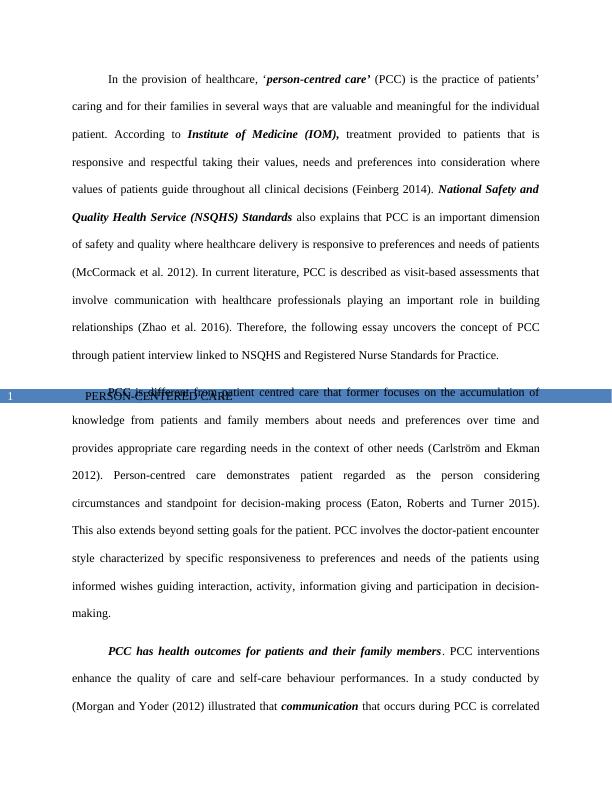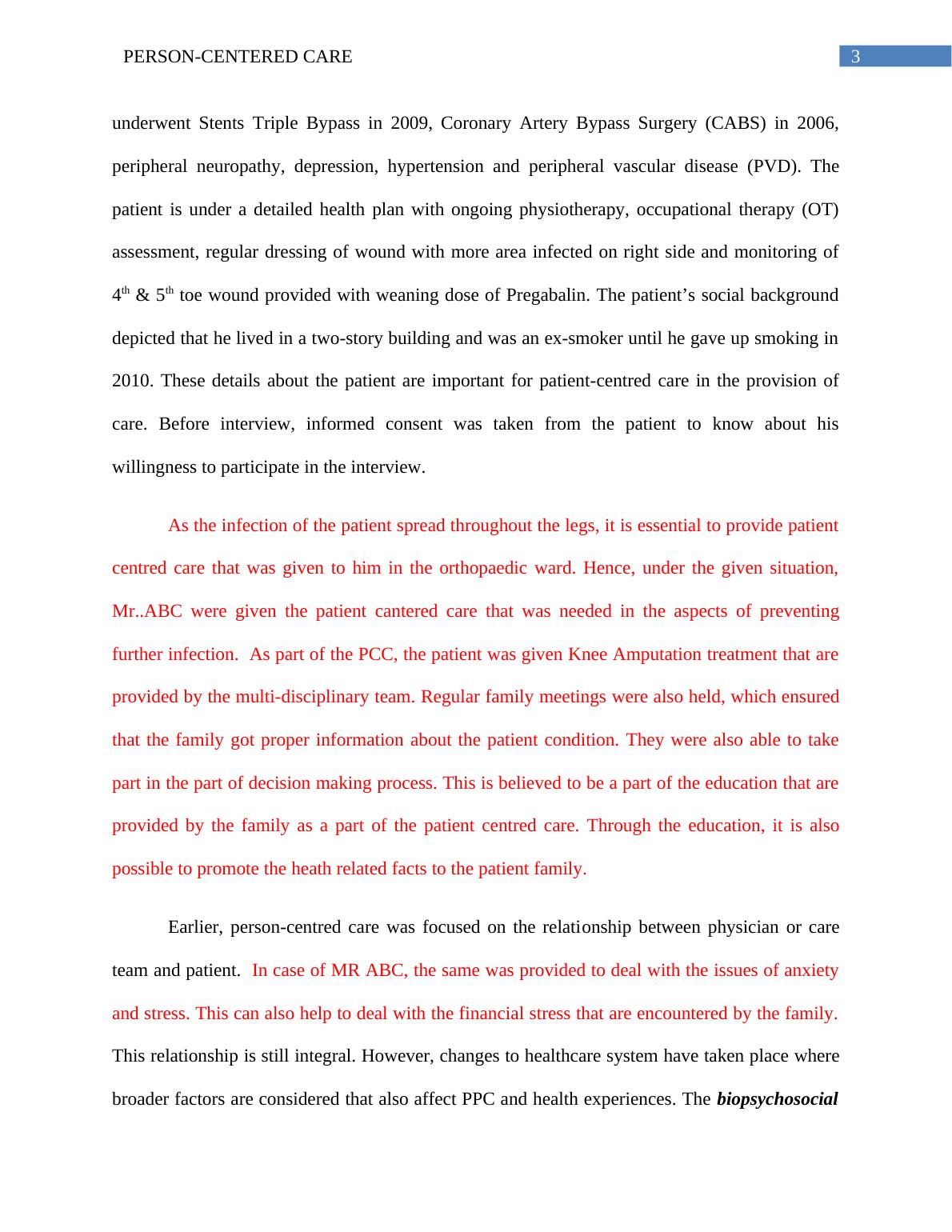Assignment on Patient-Centered Care Report
Added on 2020-05-28
14 Pages3325 Words85 Views
Running head: PERSON-CENTERED CAREPerson-centred careName of the StudentName of the UniversityAuthor note

PERSON-CENTERED CARE1In the provision of healthcare, ‘person-centred care’ (PCC) is the practice of patients’caring and for their families in several ways that are valuable and meaningful for the individualpatient. According to Institute of Medicine (IOM), treatment provided to patients that isresponsive and respectful taking their values, needs and preferences into consideration wherevalues of patients guide throughout all clinical decisions (Feinberg 2014). National Safety andQuality Health Service (NSQHS) Standards also explains that PCC is an important dimensionof safety and quality where healthcare delivery is responsive to preferences and needs of patients(McCormack et al. 2012). In current literature, PCC is described as visit-based assessments thatinvolve communication with healthcare professionals playing an important role in buildingrelationships (Zhao et al. 2016). Therefore, the following essay uncovers the concept of PCCthrough patient interview linked to NSQHS and Registered Nurse Standards for Practice. PCC is different from patient centred care that former focuses on the accumulation ofknowledge from patients and family members about needs and preferences over time andprovides appropriate care regarding needs in the context of other needs (Carlström and Ekman2012). Person-centred care demonstrates patient regarded as the person consideringcircumstances and standpoint for decision-making process (Eaton, Roberts and Turner 2015).This also extends beyond setting goals for the patient. PCC involves the doctor-patient encounterstyle characterized by specific responsiveness to preferences and needs of the patients usinginformed wishes guiding interaction, activity, information giving and participation in decision-making. PCC has health outcomes for patients and their family members. PCC interventionsenhance the quality of care and self-care behaviour performances. In a study conducted by(Morgan and Yoder (2012) illustrated that communication that occurs during PCC is correlated

PERSON-CENTERED CARE2with perceptions of patients helping them find common ground. Positive perceptions were foundto be associated with fact and better recovery from pain and discomfort. During a visit,communication greatly influences the health of patients through perceptions especially when it isachieved through common good improving their health status and increasing efficiency of careand reduction of referrals and diagnostic tests. In a research, it was analysed that positive patient-centred care in a primary setting is associated with a decrease in healthcare services utilization(Munthe, Sandman and Cutas 2012). This is greatly associated with the reduction in annualmedical care charges that is an important outcome in PCC regarding medical visits. PCC hasdemonstrated a practical style that emphasizes on patient activation and reduction in carecharges. Person-centred communication is associated with medical resources utilizationdemonstrating that patients who are patient-centred and perceived their visits have fewdiagnostic tests and referrals. The patient was admitted with the initial injury at the right toe that needed longer time toheal. The principles of PCC was applied in the given context to enhance the process of recovery. PCC carry out in settings encompassing visits. Interaction or communication is involvedwhere the quality of interactions between healthcare professionals and patients that equate PPCwith communication skills. Among fundamental component in care PCC is characterized byshared understanding, healing relationships, trust, emotional support, patient participation,activation, enablement and informed choices (Wildevuur and Simonse 2015). This is depicted inthe patient interview that was undertaken during my current work placement at the rehabilitationward. I interviewed a patient, Mr ABC, a 69-year-old male patient who is suffering from rightbelow knee amputation (right BKA). The patient’s medical history depicts that there is non-healing wound @ R> Leg, left 4th and 5th toe wound, type 2 diabetes mellitus (T2DM),

PERSON-CENTERED CARE3underwent Stents Triple Bypass in 2009, Coronary Artery Bypass Surgery (CABS) in 2006,peripheral neuropathy, depression, hypertension and peripheral vascular disease (PVD). Thepatient is under a detailed health plan with ongoing physiotherapy, occupational therapy (OT)assessment, regular dressing of wound with more area infected on right side and monitoring of4th & 5th toe wound provided with weaning dose of Pregabalin. The patient’s social backgrounddepicted that he lived in a two-story building and was an ex-smoker until he gave up smoking in2010. These details about the patient are important for patient-centred care in the provision ofcare. Before interview, informed consent was taken from the patient to know about hiswillingness to participate in the interview.As the infection of the patient spread throughout the legs, it is essential to provide patientcentred care that was given to him in the orthopaedic ward. Hence, under the given situation,Mr..ABC were given the patient cantered care that was needed in the aspects of preventingfurther infection. As part of the PCC, the patient was given Knee Amputation treatment that areprovided by the multi-disciplinary team. Regular family meetings were also held, which ensuredthat the family got proper information about the patient condition. They were also able to takepart in the part of decision making process. This is believed to be a part of the education that areprovided by the family as a part of the patient centred care. Through the education, it is alsopossible to promote the heath related facts to the patient family. Earlier, person-centred care was focused on the relationship between physician or careteam and patient. In case of MR ABC, the same was provided to deal with the issues of anxietyand stress. This can also help to deal with the financial stress that are encountered by the family.This relationship is still integral. However, changes to healthcare system have taken place wherebroader factors are considered that also affect PPC and health experiences. The biopsychosocial

End of preview
Want to access all the pages? Upload your documents or become a member.
Related Documents
Patient Centered Care Assignment PDFlg...
|18
|4977
|53
Patient-Centered Care Model: Family Nurse Practitionerlg...
|5
|996
|44
(PDF) Electronic Health Records (EHR)lg...
|16
|1048
|49
Collaborative Care Planning and Person-Centred Care in Integrated Workinglg...
|8
|2498
|422
Importance of Professional Standards and Values in Delivering Person Centred Carelg...
|9
|2576
|55
Coordinating Care for a Patient with Osteoporosis: A Case Studylg...
|3
|527
|193
